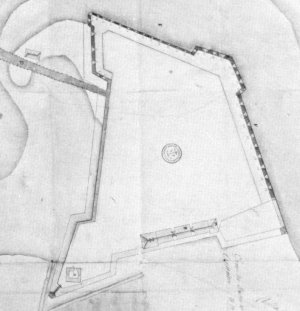Fort Louis on the Little Beach: 1691
 This fort was the first real fortification built in Placentia during
the French occupation. Until that time they had been satisfied with
picket fences or forts "qui 6taient autant comme rien." It was to be
quite a different matter with Fort Louis, the building of which was
to lead to other defence works such as the Royal Redoubt.
This fort was the first real fortification built in Placentia during
the French occupation. Until that time they had been satisfied with
picket fences or forts "qui 6taient autant comme rien." It was to be
quite a different matter with Fort Louis, the building of which was
to lead to other defence works such as the Royal Redoubt.
As we have seen, Brouillan arrived at Placentia with a large
reinforcement of men, arms and tools. Part of his instructions
concerned the fortifications that were to be built. It
appears that the governor responded to the king's wishes at the very
beginning of his period in office, as, on March 1, 1692, His Majesty
wrote to Brouillan in answer to a letter, which was obviously written
in 1691:
J'ay veu le plan du petit fort que vous avez commencc- du costs
de la Petite Grave. Je ne puis vous dire autre chose sur les
raisons qui vous ont d6terminC- a pr6f6rer ce costs 5 la Grande
Grave, et a ne vous pas servir du premier r6duit si ce n'est que
ayant une grande exp6.rience, je veux croire que vous avez fait
pour le mieux et que vous avez choisi le moins expos6 aux
insultes et le plus facile a dC-fendre.
According to this document, then, Brouillan must have undertaken a
new defense work, Fort Louis, situated on the northern point of the
gut at water level. It was very conveniently situated, as it was
built only a short distance from the gut, the entrance to the
harbour. This narrow channel, which was only 300 feet wide at low
tide, made it possible for only one ship to enter at a time, and,
even then' it was necessary to wait for favourable winds "rangent"
W.-S.-W. and to manoeuvre the ship by "la toue," that is, pulling on
ropes fixed to an anchor previously embedded on the beach. With the
cannons of the fort aimed in its direction, this passage became
almost impossible to pass through.
In 1691, Fort Louis was built with piles which were "moutonnes"
i.e., driven deep into the ground. The surrounding wall, which was
about 300 paces in circumference and irregular in construction, was
provided with two bastions, with neither flanks nor gorges, known as
"'Bourgogne" and "Royal," and four curtains made of clay and stones
piled up between stakes driven into the ground. This enclosure,
which surrounded the governor's headquarters and the barracks in the
centre, which amounted to a simple row of stakes, protected by a
battery of 26 cannons (.1692), spread around the three sides. There
was still no cistern for drawing water. From 1691 onwards, however,
the fort was constantly being improved and repaired until it finally
became a stone structure.

Sources:
Proulx, Jean-Pierre, "The Military History of Placentia." Page 35
 This fort was the first real fortification built in Placentia during
the French occupation. Until that time they had been satisfied with
picket fences or forts "qui 6taient autant comme rien." It was to be
quite a different matter with Fort Louis, the building of which was
to lead to other defence works such as the Royal Redoubt.
This fort was the first real fortification built in Placentia during
the French occupation. Until that time they had been satisfied with
picket fences or forts "qui 6taient autant comme rien." It was to be
quite a different matter with Fort Louis, the building of which was
to lead to other defence works such as the Royal Redoubt.